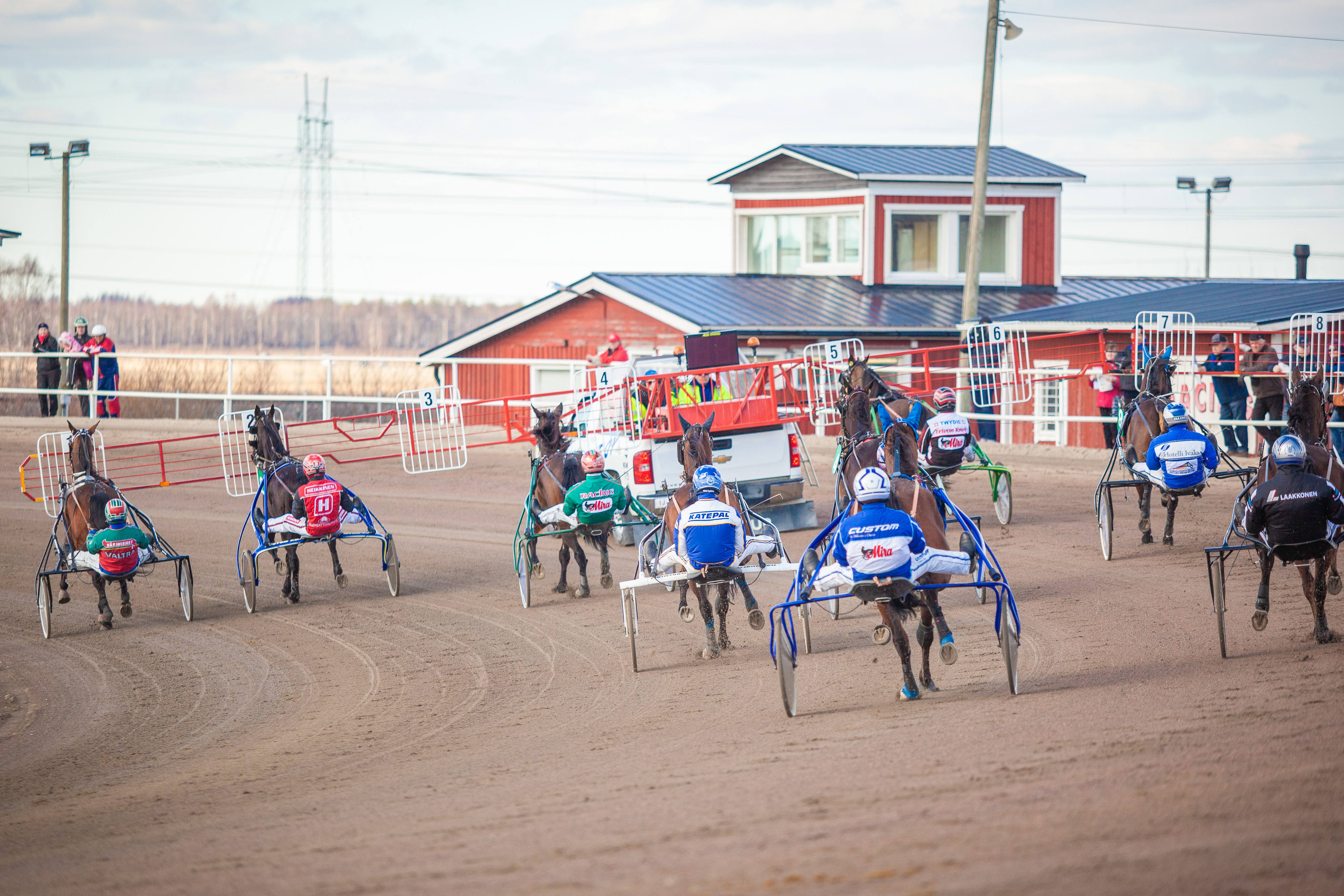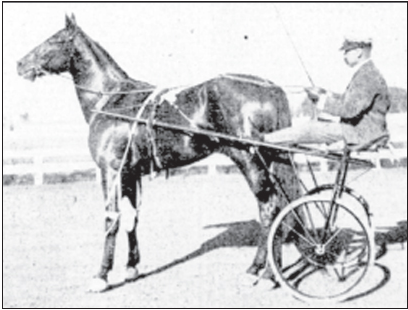|
Joe Young (horse)
Joe Young (1876-1898) was an award-winning Standardbred trotter from Peabody, Kansas at a time when harness racing was one of the most popular sports in the US. He was known for his speed and famous offspring, which include Joe Patchen and Dan Patch, a 1958 Harness Racing Hall of Fame inductee and the most famous horse in the world at the turn of the 20th century. Breeding Joe Young was foaled in Iowa in 1876. He was sold to William Ward as a colt. Joe Young first lived in Texas, after which he moved to Peabody Kansas. In Peabody, a man named C.E. Westbrook traded cattle and for him that totaled $2,000. Westbrook would be the owner for 5-6 years. The horse was "coal-black with white feet and a stripe in face." The Peabody Weekly Republican called him an "inimitable model of beauty.... eis undoubtedly the finest-shaped, best-built, cleanest-limbed, best-muscled fast trotter we have ever seen." who hitched the young Joe Young on a prairie wagon and drove him home to Kansas wher ... [...More Info...] [...Related Items...] OR: [Wikipedia] [Google] [Baidu] |
Standardbred
The Standardbred is an American horse breed best known for its ability in harness racing, where members of the breed compete at either a trot or pace. Developed in North America, the Standardbred is recognized worldwide, and the breed can trace its bloodlines to 18th-century England. They are solid, well-built horses with good dispositions. In addition to harness racing, the Standardbred is used for a variety of equestrian activities, including horse shows and pleasure riding, particularly in the Midwestern and Eastern United States and in Southern Ontario. History In the 17th century, the first trotting races were held in the Americas, usually in fields on horses under saddle. However, by the mid-18th century, trotting races were held on official courses, with the horses in harness. Breeds that have contributed foundation stock to the Standardbred breed included the Narragansett Pacer, Canadian Pacer, Thoroughbred, Norfolk Trotter, Hackney, and Morgan. The foundation blo ... [...More Info...] [...Related Items...] OR: [Wikipedia] [Google] [Baidu] |
Harness Racing
Harness racing is a form of horse racing in which the horses race at a specific gait (a trot or a pace). They usually pull a two-wheeled cart called a sulky, or spider, or chariot occupied by a driver. In Europe, and less frequently in Australia and New Zealand, races with jockeys riding directly on saddled trotters ( in French) are also conducted. Breeds In North America, harness races are restricted to Standardbred horses, although European racehorses may also be French Trotters or Russian Trotters, or have mixed ancestry with lineages from multiple breeds. Orlov Trotters race separately in Russia. The light cold-blooded Coldblood trotters and Finnhorses race separately in Finland, Norway and Sweden. Standardbreds are so named because in the early years of the Standardbred stud book, only horses who could trot or pace a mile in a ''standard'' time (or whose progeny could do so) of no more than 2 minutes, 30 seconds were admitted to the book. The horses have proportionally ... [...More Info...] [...Related Items...] OR: [Wikipedia] [Google] [Baidu] |
Harness Racing
Harness racing is a form of horse racing in which the horses race at a specific gait (a trot or a pace). They usually pull a two-wheeled cart called a sulky, or spider, or chariot occupied by a driver. In Europe, and less frequently in Australia and New Zealand, races with jockeys riding directly on saddled trotters ( in French) are also conducted. Breeds In North America, harness races are restricted to Standardbred horses, although European racehorses may also be French Trotters or Russian Trotters, or have mixed ancestry with lineages from multiple breeds. Orlov Trotters race separately in Russia. The light cold-blooded Coldblood trotters and Finnhorses race separately in Finland, Norway and Sweden. Standardbreds are so named because in the early years of the Standardbred stud book, only horses who could trot or pace a mile in a ''standard'' time (or whose progeny could do so) of no more than 2 minutes, 30 seconds were admitted to the book. The horses have proportionally ... [...More Info...] [...Related Items...] OR: [Wikipedia] [Google] [Baidu] |
Joe Patchen
Joe Patchen (May 5, 1889 – February 18, 1917) was a Standardbred racehorse foaled in Peabody, Kansas, United States. His sire was Patchen Wilkes and his dam was Josephine Young. Though best remembered for siring the famous Dan Patch, Joe Patchen enjoyed a successful racing career of his own. Racing career A large-bodied horse with unusually long legs, Joe Patchen was a strong contender on half-mile tracks. Joe Patchen won 53% of the races in which he started, and finished second in 39%. He was unplaced (out of the top four) in only 3% of his races. Though his exact career winnings are unknown, estimates place them in excess of $50,000. In August 1896, Joe Patchen broke the world records for both a half-mile and mile track by completing two laps on the half-mile Combination Park in 2:05¼ on August 8 and one lap of the mile-long Rigby Park Rigby Park was an American harness racing track in South Portland, Maine, that was open from 1893 to 1899. It was torn down in 1922 and ... [...More Info...] [...Related Items...] OR: [Wikipedia] [Google] [Baidu] |
Dan Patch
Dan Patch (April 29, 1896 – July 11, 1916) was a noted American Standardbred pacer. At a time when harness racing was one of the largest sports in the nation, Dan Patch was a major celebrity. He was undefeated in open competition, and was so dominant on the racetrack that other owners eventually refused to enter their horses against him. Instead, he ended his racing career performing time trials, and traveled extensively on exhibition, earning millions of dollars in purses, attendance gate receipts, and product endorsements. Dan Patch broke world speed records at least 14 times in the early 1900s. In 1905, he set a world's record for the fastest mile by a harness horse (1:55 – 1 minute, seconds) that stood unmatched for over 30 years. Unofficially, Dan Patch broke this record in 1906 with a clocking of 1:55. He died on July 11, 1916. His owner, Marion Willis Savage, died just one day later. Dan Patch was inducted into the Harness Racing Museum & Hall of Fame in 1953 and th ... [...More Info...] [...Related Items...] OR: [Wikipedia] [Google] [Baidu] |
Harness Racing Museum & Hall Of Fame
The Harness Racing Museum & Hall of Fame is a museum in Goshen, New York. The museum collects and preserves the history of harness racing and serves as a hall of fame for the American Standardbred horse. Orange County is the birthplace of Hambletonian 10, the ancestor of all American Standardbred horses, and many of the early Hambletonian races were held in Goshen at the Good Time Park mile track. Established in 1838, the neighboring half-mile Historic Track is a National Historic Landmark, the oldest harness horse track still in use in the United States. Stables still operate on the grounds, and races are held annually. The museum opened in 1951, during Goshen's Hambletonian Stake era. Hall of Fame The half-timber building that houses the museum was built as a stable in 1913. It houses artwork by famous equine artists and racing memorabilia dating back to the start of trotting. Exhibits include more than 1,700 paintings, lithographs and sculptures, 19,300 photographs, hu ... [...More Info...] [...Related Items...] OR: [Wikipedia] [Google] [Baidu] |
Messenger (horse)
Messenger (1780 – January 28, 1808) was an English Thoroughbred stallion imported into the newly-formed United States of America just after the American Revolution. He is most famous for being the great-grandsire of Hambletonian 10, the father of all American Standardbred horses. Though he did not have a long racing career himself, he was a common ancestor in many successful racing horses into the 20th century. Breeding Messenger was a grey Thoroughbred bred by John Pratt, Esq. of Newmarket, England He was most likely foaled at Oxford Stud in Balsham, CambridgeshireTesioPower 2000, Stallions of the World in 1780. In May 1788, Sir Thomas Benger imported Messenger to Pennsylvania by ship. Legend goes that the eight year old horse ran down the gangplank "so rambunctiously that it took two men to keep him under control," when the rest of the horses were too weary to move after the long voyage. In 1793, Messenger was sold to Henry Astor, the brother of John Jacob Astor. He was ... [...More Info...] [...Related Items...] OR: [Wikipedia] [Google] [Baidu] |
Hambletonian 10
Hambletonian 10, or Rysdyk's Hambletonian, (May 5, 1849 – March 27, 1876) was an American trotter and a founding sire of the Standardbred horse breed. The stallion was born in Sugar Loaf, New York, on 5 May 1849. Hambletonian has been inducted into the Immortals category of the Harness Racing Hall of Fame. Origin and early years Hambletonian 10 was bred by Jonas Seely, Jr., on his farm at Sugar Loaf in Orange County, New York. He was sired by Abdallah, a grandson of the hugely influential Thoroughbred sire, Messenger. Abdallah was ugly in body and temperament, so much so that he was sold to a fish peddler for $5. Hambletonian's dam was known as the Charles Kent mare or the "Kent Mare", sired by Bellfounder (GB), an imported Norfolk Trotter. Hambletonian was inbred to Messenger (GB) (1780) in the third and fourth generations (3x4x4x4). Seeley's hired hand, William Rysdyk, cared for the mare and foal. Rysdyk became so attached to the pair and was so convinced that the f ... [...More Info...] [...Related Items...] OR: [Wikipedia] [Google] [Baidu] |



